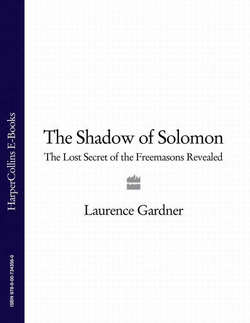Читать книгу The Shadow of Solomon: The Lost Secret of the Freemasons Revealed - Laurence Gardner - Страница 36
The Great Divide
ОглавлениеThe reign of Queen Victoria, Regina et Imperatrix, saw an amazing boom in masonic interest. In London, the number of lodges increased from 100 to 382, and the provinces showed a commensurate increase. On a global scale, English lodges numbered 2,543 throughout the British Empire by the end of the 19th century.19 Clubs and Societies multiplied considerably within Victorian middle-class society, and Freemasonry was by far the largest and most influential of these in a period when imposing masonic halls and opulent lodges were built in a number of major centres. Although not at the Jubilee Grand Lodge with Edward, Arthur and Albert in 1897, Prince Edward’s younger brother Leopold (who had died shortly before) was also a Freemason, and the Craft had become a truly royal institution. Throughout the land, masons, by definition, achieved a celebrity status, opening churches, theatres and pavilions, and Freemasonry, with openly paraded regalia, became a focus of public ceremony. The foundation stone for the Shakespeare Memorial Theatre at Stratford-on-Avon was laid with full masonic honours by William, Lord Leigh, Provincial Grand Master of Warwickshire, in 1877.20 Similar events were held to establish Truro Cathedral in 1880, and the York Institute in 1883.21 Truro was the first cathedral to be consecrated in England since the 16th-century Protestant Reformation, and Prince Edward’s laying of the foundation stone led to other masonic cathedral foundations at Rochester, Peterborough and Liverpool.
Regular masonic newspapers also emerged in this era: The Freemason in 1869 and The Freemason’s Chronicle in 1875. There was nothing discreet about being a Freemason in those times—in fact, quite the opposite; it was truly a mark of social prestige. Even private groups that were in no way masonic made applications for warrants to become lodges. The Savage Club, for example—a fraternity of writers, artists and thespians of London’s bohemian sect—was consecrated at Freemasons’ Hall on 18 January 1887, with the actor Sir Henry Irving as its Treasurer.22 When French masons came to Britain, they could hardly believe the pomp and pageantry of the English institution, nor indeed the personal cost of it to members. Since the French Revolution (1789-99), such displays of class and financial status had become unfamiliar to them, while as republicans they were baffled by the apparent preoccupation with monarchy.
The French masonic journal Le Monde Maçonnique went so far as to criticize English Freemasonry for its cathedral bequests, claiming that it should concentrate rather more on moral architecture. In line with this, the Grand Orient of France asserted that the United Grand Lodge of England was like ‘a body without a soul’. In retaliation, The Freemason expressed the view that the English system was more solid and grounded than that of the French, which it described as too mystical and esoteric. There had always been differences because the Franco-Scottish system was founded on far more ancient traditions, whereas the more lately contrived English system had spent nearly two centuries endeavouring to find its feet. And it found them in what was a regeneration of medieval feudal benevolence—a realm of aristocratic and wealthy benefactors, adherents of the Empire who aspired to a popular Robin Hood image without having to steal from the rich. They were the rich.
